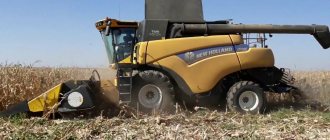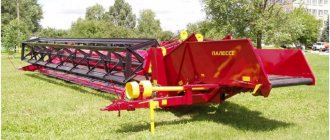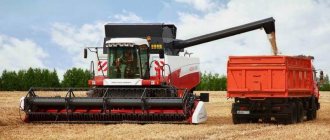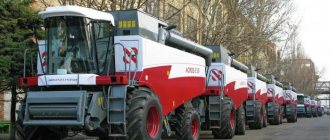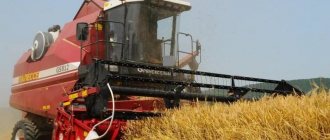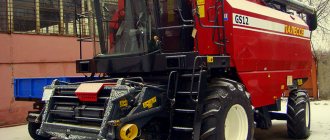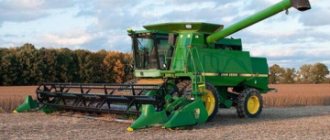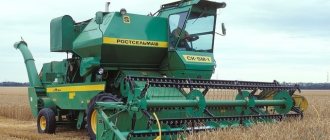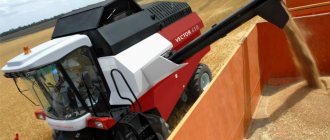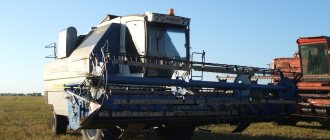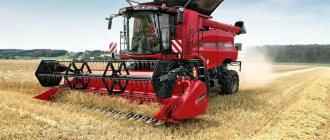Purpose
Case 2366 is intended for medium-sized enterprises. For companies with small areas, this model is ideal. Again, private farmers will like special equipment. With a small load, its payback, taking into account the rather large cost, will be extremely low.
The series is distinguished by excellent driving characteristics, and the engine power is enough to perform work in fields with any landscape and under increased loads. Case 2366 allows you to efficiently and quickly harvest small seeds, legumes, grains, oilseeds and other crops in medium-sized areas. The model is perfect for the harsh Russian climate. Severe operating conditions and low fuel quality are not a problem for the Case 2366 - the machine shows high efficiency regardless of external factors.
Modifications and features
Production of Case 2366 started in 1998 and continued until 2004. The production of the series has now been completed. Over the course of 6 years, 2 generations of the combine were developed; the differences between them were only in power characteristics.
The line of models consisted of 2 versions (2366 and 2388). Again, they were practically no different in terms of design and design features, which is why they were combined into one group. A less powerful variation (Case 2366) had a hopper with a capacity of 6300 liters, and a more powerful one (Case 2388) had a hopper with a capacity of 7400 liters.
Series features:
- high-torque motor with a large power reserve;
- reliable headers with a wide grip;
- reverse inclined conveyor;
- spacious operator's cabin with climate control;
- a bunker with a significant unloading speed (complete emptying takes several minutes);
- hydraulic disc brakes and hydraulic transmission adjustment;
- single-rotor Axial-Flow type system. This mechanism is considered the main advantage of Case combines. The technology allows you to harvest a variety of crops with minimal losses and maximum productivity. The special design of the rotor under the influence of centrifugal force and friction contributes to the careful separation of raw materials. The grains remain intact and damage is minimal;
- reduced number of movable elements in assemblies and assemblies;
- non-stop operating cycle, including at the time of unloading from the bunker.
There are practically no disadvantages to this technique. The main disadvantage is the significant cost and high cost of spare parts and elements. However, significant reliability completely compensates for these shortcomings.
Video
All Case products share the following features:
- unique technologies and special mechanisms allow you to work with different types of crops;
- the number of moving units and elements in combine harvester systems has been reduced to a minimum. Such a solution reduces the likelihood of breakdown and increases service life;
- unique single-rotor Axial Flow system, which allows you to maintain high productivity with lower resource costs. The grain mixture is cleaned using friction without damaging its integrity, and the output is clean grain without damage;
- thorough threshing of grain with minimal losses.
The 2300 series is the most popular in the Case line of combines. It appeared in 1998 and included 2 modifications (models 2388 and 2366). Products in this series have a modern cabin with a climate control system, an improved drive belt and a new type of tires that reduce soil compaction and soil pressure. Models 2388 and 2366 are similar in characteristics, and the only difference is the volume of the hopper. The 2366 version has a capacity of 900 liters less (6300 liters).
News here.
The first copies of Case 2366 appeared in 1998 (the equipment entered the Russian market much later). The second generation of the combine is currently available, which differs from the debut version only in the power parameters of the power plant. Among the features of the technology, it is worth highlighting the mechanism for quick unloading of the hopper (several minutes) and the large area of the ventilation system and sieves, which improves the cleaning process.
In the Russian market, the Case 2366 model has received little distribution, despite the presence of a developed dealer network. At the same time, in terms of productivity and quality of harvested grain, the combine remains the leader in its segment.
Case 2366 equipment is designed for use on medium-sized farms. The machine has good driving performance and sufficient power to operate under high loads. The main area of application of the combine is harvesting various types of agricultural crops (corn, cereals, small seeds and others).
Specifications
Overall dimensions (in transport condition):
- length – 6750 mm;
- width – 3280 mm;
- height – 3810 mm;
- wheelbase – 3500 mm;
- ground clearance - 508 mm.
The mass of the combine is 10300 kg.
Performance characteristics:
- Hopper capacity – 6300 l;
- maximum unloading speed – 100 l/sec (depending on operating conditions and type of crop);
- unloading height – up to 3900 mm;
- standard header working width – 4900 mm;
- number of straw walkers – 6.
Wheel size:
- driving – 480/70-R24;
- managers - 650/75R32.
Engine
The Case 2366 is equipped with a proprietary 6 TAA 830 diesel engine manufactured under license from Cummins. A single-row unit with direct injection, sequential air cooling and turbocharging allows the combine to cope with the most difficult tasks. The engine uses a unique CAPS fuel system with classically designed injectors and an electronically controlled pump. The unit differs from analogues in its significant torque even at low speeds and a long service life.
Characteristics of motor 6 TAA 830:
- working volume – 8.3 l;
- rated power – 240 (325) kW (hp);
- number of cylinders – 6.
The fuel tank capacity is 681 liters.
Features and device
The design of the combine uses a single-rotor system, which makes it possible to work with high productivity at the lowest cost. The rotor has a device that carefully separates the grains. The design features improved operating technology and is equipped with improved power units.
The combine can be quite simply transferred from the active state to the reverse state. From the bunker, grain enters the grain crusher at high speed, so you can unload the combine directly during operation if you reduce the rotation of the motor. The design of the unit is simple, so you can do minor repairs yourself. The header has a large width, which allows you to get maximum grip and change the angle of inclination when the terrain changes.
Design and operating features
The Case 2366 Series uses the Axial-Flow single-rotor threshing design, which features gentle handling of fragile crops. The rotor in this series replaces the rear beater, threshing drum and straw walkers used in classic combines. A rotary threshing and separating device is located along the combine, then a beater with 3 blades is placed, which removes straw beyond the boundaries of the thresher. There is a stone catcher in front of the rotor that protects the mechanism components from foreign objects. Characteristics of the threshing and separation system:
- rotor diameter – 762 mm;
- rotor length – 2800 mm;
- rotor speed (low/medium/high speed) – 250-400/400-700/700-1125 rpm.
The system again includes a 3-section concave with position display and electronic control and an auger frame with 5 augers.
The grain mass is collected using a reaper. In the basic configuration, Case 2366 is equipped with a header with a 4900 mm gripper. There is a hydraulic reverse function for the feeder chamber.
The cleaning system is represented by a chaff sieve with an adjustable bar, a shoe sieve with a bar and a proprietary Cross Flow fan with a rotation speed of 450-1250 rpm. Cleaning is carried out by intersecting air flow. The total cleaning area reaches 5.1 sq.m, which allows you to quickly perform high-quality grain cleaning.
The following elements are responsible for the transportation and storage of grain mass:
- grain lift with top drive;
- top drive clean grain lift;
- unloading auger with rotating and locking function;
- bunker with a capacity of 6.3 cubic meters. Unloading is carried out quite quickly and takes no more than 2-3 minutes, thereby reducing equipment downtime.
The threshing process consists of 3 main stages in a single rotating mechanism system:
- receiving plant mass and gradually moving it in a spiral to the end part along the entire plane of the rotor;
- repeated movement of the incoming mass through the concave. At this stage, separation is carried out by gentle friction (threshing purity reaches 90%);
- separation and threshing of the remaining part of the grain with the movement of the plant mass to the rear area of the rotary unit to specialized agitating and shaking whips, ensuring final cleaning of the grain. In this phase, the mass is transferred to the spreaders through a beater.
The operation of the chassis of the equipment is based on hydraulics, which is responsible for the position of the header, the brake system and the gearbox. This ensures smooth running of the machine and high-quality cleaning. The combine's transmission is a 3-speed hydrostatic drive, complemented by hydraulic disc brakes. Specialized tires with a large surface area reduce ground pressure by 38% compared to their predecessors. This feature allows the Case 2366 to be used in difficult terrain and waterlogged soil.
The Case 2366 series combines use an ergonomic operator’s cabin that corresponds to the “Lux” category and is complemented by a climate control function. A soft chair with several adjustments is installed inside. The operator can adjust it to suit himself, taking into account the wide panoramic view, this guarantees ease of use. A multi-function lever that fits comfortably in your hand is used to control the reel, header functions, unloading auger, travel speed and inclined conveyor. Thanks to this, even an inexperienced operator can handle operating the machine. Case 2366 combines are equipped with an AFS system, which, together with a GPS satellite system, allows you to collect and analyze information about soil fertility and field yield, which is extremely convenient for further predicting the choice of seeds, fertilizers and crop protection products.
The combine service points are located in convenient places, which allows you to spend a minimum of effort on basic operations for diagnosing and replacing consumables.
Design and service features
The design of Case 2366 differs little from Case 2388. Both combines are equipped with powerful diesel engines, and the operation of the chassis is based on hydraulics. Through it, the brake system, the position of the header and the transmission are adjusted. The equipment is characterized by a smooth ride due to the features of the transmission, the main elements of which are a 3-speed hydrostatic drive and hydraulic disc brakes. This feature makes the combine more mobile and allows you to work in narrow areas of the field.
Main elements of Case 2366:
- reliable header with wide grip;
- a unique rotor with Axial-Flow technology, which reduces operating costs and increases the quality of threshing due to the long stay of the grain mass in the threshing zone. Improved performance is achieved through the use of a single rotor and a simpler design compared to classic combines. Axial-Flow technology provides minimal grain damage, gentle threshing, reduced load on the power unit, continuous and smooth crop flow, reduced wear on threshing elements and improved grain separation. The rotor itself has a lower through part and an upper blind part in its design. The first is made in the form of module sections, which are selected specifically for a specific crop. The upper part allows you to regulate the period of stay of the grain mass in the threshing zone;
- cleaning system with a uniform flow of plant matter. Adjustable chaff sieve and shoe sieve slats facilitate more efficient cleaning. Three-section concave with status display and electrical control allows you to effectively control the threshing process, which is carried out in 3 stages. The grain mass passes through the rotor area, concave and rear of the rotor, which ensures maximum cleaning. Separation is carried out using a powerful Cross Flow fan;
- feeder chamber with hydraulic reverse system;
- a spacious bunker that allows you to store a large amount of grain. In this parameter, Case 2366 is slightly inferior to the Case 2388 model. The hopper is unloaded in a few minutes.
The combine cabin has a high level of comfort. It can easily accommodate not only the operator, but also a partner. The driver's seat has several adjustments, allowing it to be customized to suit the operator's needs. The cabin is also equipped with an air conditioning system and an air purifier. The main mechanisms and components are controlled from the cab via an on-board computer, which increases the efficiency of the combine harvester.
Advantages of the Case 2366 model:
- special devices allow the equipment to work with more than 100 types of crops;
- high quality of threshing and grain integrity ensure a long shelf life in the future;
- the simplicity of the design of units and main components makes service more accessible;
- A wide header improves the productivity of the equipment. In this case, the cutting mechanism can be adjusted taking into account the field topography;
- use of a unique single-rotor Axial Flow system, which reduces labor costs and increases machine efficiency;
- Grain can be poured into a transport vehicle from a bunker without stopping the combine.
Disadvantages of the Case 2366 model:
- high cost of spare parts and components;
- poor quality of work with the straw remaining after working with the ears;
- underdevelopment of service centers.
Case 2366 requires regular maintenance, which is similar to the maintenance of the Case 2388 model. The weakest element of the combine is considered to be the header beam. Problems with it lead to wear of the scythe and disruption of the adjustment of the gap between the cantilever auger and the bottom of the header. The period between routine maintenance of equipment is 1000 operating hours. The oil in the combine should be changed every 250 operating hours.
Despite the problems described, Case 2366 remains one of the most reliable and high-quality models in its segment.
